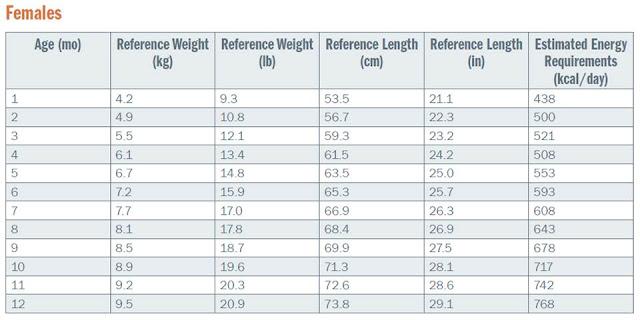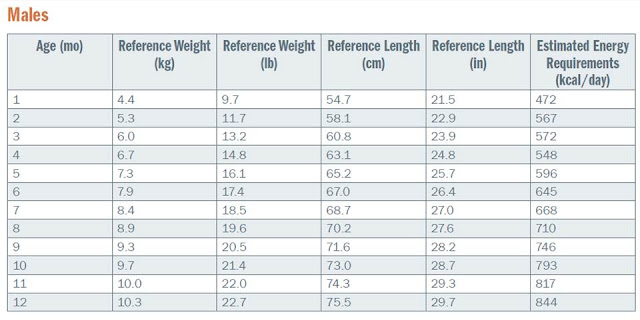I was talking to someone the other day about babies, and the topic of how to feed a baby came up. The main topic we discussed was the recent "epidemic" of ... don't you dare call it obesity because they're still growing ... increasing incidences of children being overweight. A big factor is what the feeding practices are. So my question of the day is:
How do you know if you're overfeeding a baby?
Let's talk about Calories first. Compared to their weight, babies need a ton of Calories to support their rapid state of growth. As the baby grows, the more energy he or she will need. According to a publication by the USDA:
An infant’s energy or caloric requirement depends on many factors, including body size and composition, metabolic rate (the energy the body expends at rest), physical activity, size at birth, age, sex, genetic factors, energy intake, medical conditions, ambient temperature, and growth rate.That's a lot to consider, so here are two tables taken from that same publication that describes how many Calories the average baby needs.
We also have to consider what types of foods are being eaten. Here's where life get's complicated. Depending on how old and large a baby is, the foods that should be given change. For instance, it is recommended to only give formula or breastmilk (more highly recommended) for the first 4-6 months. Many resources now say to wait until 6 months. Giving other foods too early can increase the risk for GI problems, allergies, and gaining weight.
Generally, once a baby is eating mushed-up regular food, we recommend the same types of healthy food as adults: fruits, vegetables, whole grains, lean meats, and low-fat dairy. No cow's milk should be given until 12 months because it may increase the likelihood of an allergy, and it may have too many minerals for their little kidneys to handle. Would it be healthy to feed an adult an all-starch or all-meat meal? No. It's the same concept for babies; they need a variety of foods throughout the day and during mealtime. A general serving size guide is to offer one tablespoon of each food per years in age.
You know all those fatty, delicious foods we tell adults to watch out for? In reality they're just as bad for babies. Go figure? It's recommended to not feed babies: bacon, sausage, lunch meats, hot dogs, French fries, cookies, candies, cakes, and/or sweetened drinks (iced tea, soda). It's because of their fat, sugar, and/or Calorie content. Also, honey isn't recommended until 12 months because it may be contaminated with the bacteria that causes botulism. Think about it;if you give a one-year-old a soda worth 150 Calories, that's almost 20% of the energy they need in a whole day. If you're feeding a baby one of the forbidden foods, that could be an indicator that he or she is getting overfed.
Also, if you're forcing food after he or she is full, that could be an indicator that you're overfeeding. Here are some WIC guidelines for knowing when a baby is full. If a baby is on the bottle or boob, signs of fullness are:
- Closes lips
- Stops sucking
- Spits the nipple out
- Turns head away
- Pushes food away
- Closes mouth tight
- Slows down eating
- Starts playing with food
So to sum things up, we just gotta pay attention for signs of fullness, keep offering the 5 major food groups, and watch out for those foods that aren't recommended. Sounds simple enough, right? ;) Like I said, it all looks good on paper.

